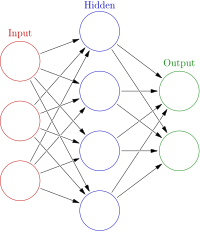
Photo from wikipedia
Background and Objectives: This study investigated the usefulness of deep neural network (DNN) models based on 18F-fluorodeoxyglucose positron emission tomography (FDG-PET) and blood inflammatory markers to assess the therapeutic response… Click to show full abstract
Background and Objectives: This study investigated the usefulness of deep neural network (DNN) models based on 18F-fluorodeoxyglucose positron emission tomography (FDG-PET) and blood inflammatory markers to assess the therapeutic response in pyogenic vertebral osteomyelitis (PVO). Materials and Methods: This was a retrospective study with prospectively collected data. Seventy-four patients diagnosed with PVO underwent clinical assessment for therapeutic responses based on clinical features during antibiotic therapy. The decisions of the clinical assessment were confirmed as ‘Cured’ or ‘Non-cured’. FDG-PETs were conducted concomitantly regardless of the decision at each clinical assessment. We developed DNN models depending on the use of attributes, including C-reactive protein (CRP), erythrocyte sedimentation ratio (ESR), and maximum standardized FDG uptake values of PVO lesions (SUVmax), and we compared their performances to predict PVO remission. Results: The 126 decisions (80 ‘Cured’ and 46 ‘Non-cured’ patients) were randomly assigned with training and test sets (7:3). We trained DNN models using a training set and evaluated their performances for a test set. DNN model 1 had an accuracy of 76.3% and an area under the receiver operating characteristic curve (AUC) of 0.768 [95% confidence interval, 0.625–0.910] using CRP and ESR, and these values were 79% and 0.804 [0.674–0.933] for DNN model 2 using ESR and SUVmax, 86.8% and 0.851 [0.726–0.976] for DNN model 3 using CRP and SUVmax, and 89.5% and 0.902 [0.804–0.999] for DNN model 4 using ESR, CRP, and SUVmax, respectively. Conclusions: The DNN models using SUVmax showed better performances when predicting the remission of PVO compared to CRP and ESR. The best performance was obtained in the DNN model using all attributes, including CRP, ESR, and SUVmax, which may be helpful for predicting the accurate remission of PVO.
Journal Title: Medicina
Year Published: 2022
Link to full text (if available)
Share on Social Media: Sign Up to like & get
recommendations!